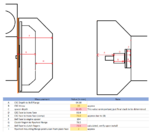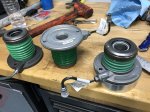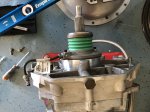captdistraction
GrumpyRacer
(buckle up, another long post) Another issue I'm tracking on my racecar: I believe I had some clutch slippage (or I was blowing away the tires coming out of a corner per Drew, either scenario was possible).
At Arizona Motorsports park, there's a tight turn with a reducing radius on exit (see first picture). In it, I was limping the car along in third because I had enough torque to pull me through (and I was fighting braking issues), but later in a 30 minute race, I decided to try to build some speed by dropping into second to keep the motor in its rev range. However as I exited the turn under power and shifted into third, the engine would rev a bit freely as if I was slipping the clutch or spinning tires. I didn't run video or telemetry (of course) as I was hunting issues with brakes and didn't have time to set anything up between sessions.That said, if it was tire slip, I didn't induce any noticeable yaw into the car each time (IE the car remained pointed where I wanted it to go) until I lifted and then let it settle down. I had this happen 4-5 times before I went back to just riding out third gear with no issues. Nowhere else on track (which is why it's a 50/50 call in my mind between clutch and inside tire spin)
The car's setup:
Exedy hyper single clutch (about 1/3 into its life),
Tremec magnum XL transmission
steeda clutch assist spring.
Was using a standard ford "long" slave cylinder. I thought I had some funniness with the clutch, in one case the pedal wasn't returning to full height in the pits, had to lift it up with my feet (I think the clutch spring is to blame), but I figured I should pull the transmission to have a look. Sure enough, the CSC (slave) fell apart as I pulled the transmission out, it had possibly overextended, however the unit was being held together by the clutch/transmission interface, and would indeed work. no fluid leak or anything like that.
I would point the finger there, but I also don't know how to properly evaluate a clutch surface. So I've posted some pictures of that as well. everything looks fine to me, its somewhat shiny, but at the same time I can still see machining marks. i keep two of these clutch kits around, so I can always swap to the other and send one off for rebuild. Plenty of friction material on the disc and no odd grooving. no loose bolts on the flywheel or clutch (or anywhere).
While I think its easy to point the finger there (and I'm rectifying that issue by using a kohr spacer and a short CSC from a late gt500 when I put this back together), its also hard to ignore that track layout having a great opportunity to blow away a tire coming out of it with all the lateral load. I colored the track map with green coming out of the corner in 2nd, light blue at shift point to 3rd, yellow in third with grip, red where she was roasting them. The track map isn't perfect as there's still radius there as you track the car out and on to that shorter straight approaching T10.
Thoughts? Should I rebuild that clutch or just put it back in and go? My instinct is to just reinstall it as is, looks fine to my uneducated eyes and get that known bad CSC replaced with the recommended setup per Dean/Kohr and see what shakes.

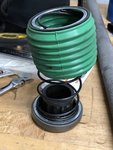
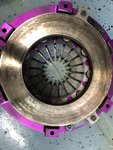
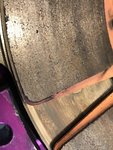
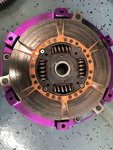
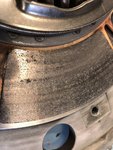
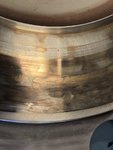
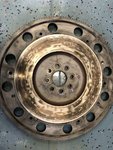
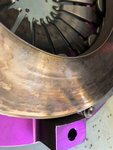
At Arizona Motorsports park, there's a tight turn with a reducing radius on exit (see first picture). In it, I was limping the car along in third because I had enough torque to pull me through (and I was fighting braking issues), but later in a 30 minute race, I decided to try to build some speed by dropping into second to keep the motor in its rev range. However as I exited the turn under power and shifted into third, the engine would rev a bit freely as if I was slipping the clutch or spinning tires. I didn't run video or telemetry (of course) as I was hunting issues with brakes and didn't have time to set anything up between sessions.That said, if it was tire slip, I didn't induce any noticeable yaw into the car each time (IE the car remained pointed where I wanted it to go) until I lifted and then let it settle down. I had this happen 4-5 times before I went back to just riding out third gear with no issues. Nowhere else on track (which is why it's a 50/50 call in my mind between clutch and inside tire spin)
The car's setup:
Exedy hyper single clutch (about 1/3 into its life),
Tremec magnum XL transmission
steeda clutch assist spring.
Was using a standard ford "long" slave cylinder. I thought I had some funniness with the clutch, in one case the pedal wasn't returning to full height in the pits, had to lift it up with my feet (I think the clutch spring is to blame), but I figured I should pull the transmission to have a look. Sure enough, the CSC (slave) fell apart as I pulled the transmission out, it had possibly overextended, however the unit was being held together by the clutch/transmission interface, and would indeed work. no fluid leak or anything like that.
I would point the finger there, but I also don't know how to properly evaluate a clutch surface. So I've posted some pictures of that as well. everything looks fine to me, its somewhat shiny, but at the same time I can still see machining marks. i keep two of these clutch kits around, so I can always swap to the other and send one off for rebuild. Plenty of friction material on the disc and no odd grooving. no loose bolts on the flywheel or clutch (or anywhere).
While I think its easy to point the finger there (and I'm rectifying that issue by using a kohr spacer and a short CSC from a late gt500 when I put this back together), its also hard to ignore that track layout having a great opportunity to blow away a tire coming out of it with all the lateral load. I colored the track map with green coming out of the corner in 2nd, light blue at shift point to 3rd, yellow in third with grip, red where she was roasting them. The track map isn't perfect as there's still radius there as you track the car out and on to that shorter straight approaching T10.
Thoughts? Should I rebuild that clutch or just put it back in and go? My instinct is to just reinstall it as is, looks fine to my uneducated eyes and get that known bad CSC replaced with the recommended setup per Dean/Kohr and see what shakes.









